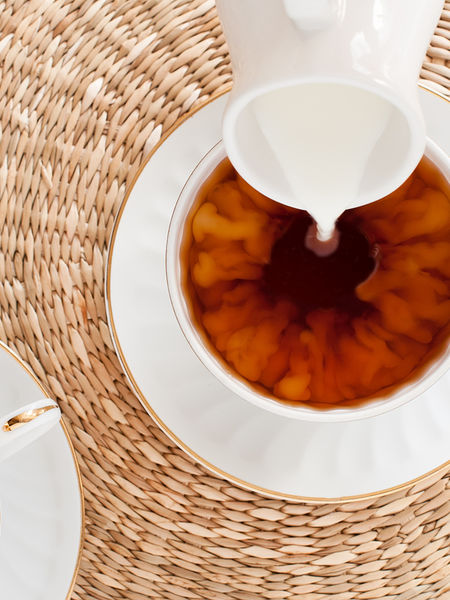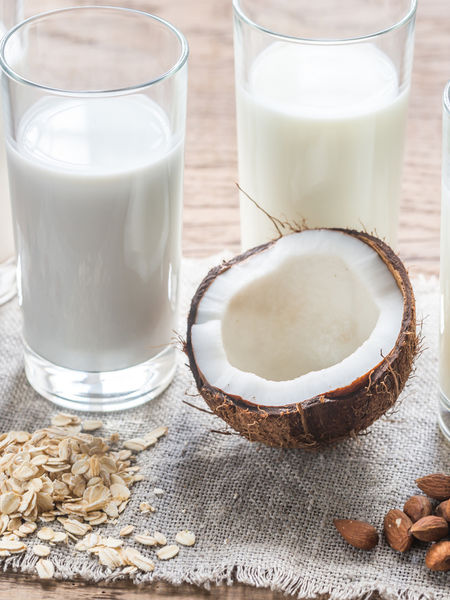Milk Choices for Tea


Dairy and Non-Dairy: YEA OR NAY?
Once upon a time, “Lemon or milk?” was the question a tea hostess would ask her guests as she presided over the afternoon repast. Lemon has pretty much taken a back seat at most tea shops, although there are plenty of people who love the tang of citrus in their black teas, and some Darjeeling lovers swear lemon brings out the Indian tea’s fruity essence.
AMERICANS LOVE MILK
Here in the USofA, thanks to ardent lobbyists and clever advertising for the dairy industry, we’ve grown to love everything milky from ice cream and frozen yogurt to cottage cheese and sour cream.
Dairy choices for tea lovers are legion. Although cream may separate in hot tea, it has its champions. Most milk-in-tea lovers choose either whole milk or 2% because fat is indeed a flavor carrier and they work well with black tea favorites. For those who avoid cream, but want something rich, half-and-half seems like the idea compromise, adding a soft edge to the tea without overpowering its essential astringent elegance.
Non-fat or skim? Even the strictest dieter will attest that the lack of fat in skim milk makes for a milk-flavored water addition to our tea vs incorporating a rich, creamy texture.
MILK IN ALL TEA CHOICES? NO!
Adding milk to anything but black teas was previously deemed a no-no, but with the surge of boba (tapioca ball) tea, even fresh greens have taken on milk. It not only alters the color to a soft sage, it alters its vegetal flavor often to the point of masking it altogether.
Oolong seems to be spared of milk lovers, perhaps because its integral floral flavor and fragrance don’t marry well with dairy. Undeterred, tea marketers championed “milk oolong” which has no milk in it, uses no dairy to grow it, but does indeed have a natural creamy essence which is a part of its natural flavor. Ad copy writers seized upon this anomaly to promote this oolong tea category to milk-loving Americans.
NON-DAIRY CHOICES
Anti-dairy diet and health critics have caused huge upsets in how the consumer views milk, and that has impacted the milk-in-tea fan. That brings us to the plethora of non-dairy choices that consumers have embraced for their morning corn flakes, in their baked goods, and any recipe that calls for milk: Almond Milk, Cashew Milk, Rice Milk, Soy Milk, Coconut Milk, and hybrids of two or more of these products like rice and soy.
There is, to be sure, no dairy in any of these nut, bean or fruit categories. The word milk is used to conjure up the familiarity of milk via its color (a thin white) and its benefits as a non-dairy product, promoted as healthful.
The claims about health are, alas, dubious. Nuts, a high-quality source of plant protein, are a scant presence in almond or cashew milks which are made by soaking nuts in water, usually overnight, and then put into a blender and mixed until a frothy “milk” is formed. Commercial products add sweeteners, stabilizers, and flavorings (vanilla or chocolate, for example) to make what is actually a nut-flavored water more palatable.
Milks from rice or soybeans use similar methods to extract the “milk” from these foods. Those with concern for gluten have embraced rice milk and those seeking protein with every food, love soybeans. Vulnerable to pesticides, soy products should be a consideration, especially soy milk. Most are sold on the shelf, but some in refrigerated sections, and prices are modest.
COCONUT MILK
Coconut milk is a misnomer, too, but it is, of all these choices, a natural byproduct of the coconut which offers an unctuous water, a cream and a watery “milk” in addition to “meat” which is actually the hard chunky fruit inside the coconut. If you enjoy a slight essence of coconut flavor in your tea, either coconut milk and coconut cream will offer a luxurious texture. They’re available in cans or boxes, often in the international aisles of grocery stores which sell Thai or Indian foods. Specialty markets for these cuisines have them in abundance, and their prices are modest. Refrigerate after opening.
MILK IN INDIAN CHAI: A TRADITION
For purists, however, milks of any type rarely enhance the tea except in spicy chais. The sharpness of the usual additions of allspice, pepper or clove, or other traditional spices, are made more palatable with the addition of milk and, it’s a tradition! Classic Indian spice chai uses oxen milk, but cow’s milk works quite well. The milk offers nutrition, the spice offers digestive qualities, and the tea provides clarity and well-being.
OTHER NATURAL MILKS
Alas, the tang of goat or sheep milk only adds a sourness to tea, so they’re best avoided.
YOU ARE IN CHARGE
As Confucius said, “Let your palate be your guide” in all choices food or drink. Remember, it is your sense of taste that should be the final arbiter of what teas you savor and what, if any, additions you’d like to incorporate.
For the curious and adventurous, do try non-dairy “milks” or cow’s milks with different percentages of fat. Taste, judge for yourself, then opt in or out for upcoming tea experiences.
